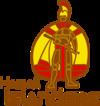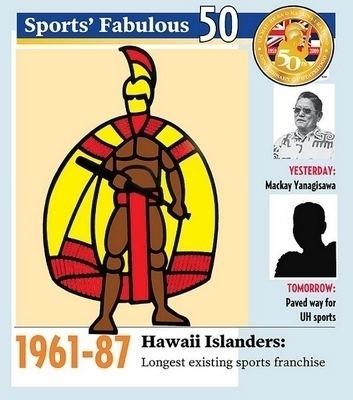Founded 1955 | League titles 1975, 1976 | |
Previous Chicago White Sox (1987)Pittsburgh Pirates (1983–1986)San Diego Padres (1971–1982)California Angels (1969–1970)Chicago White Sox (1968)Washington Senators (1965–1967)Los Angeles Angels (1962–1964)Kansas City Athletics (1961) Division titles 1970, 1975, 1976, 1977, 1979, 1980, 1984 Previous names Hawaii Islanders (1961–1987) | ||
The Hawaii Islanders were a minor league baseball team based in Honolulu, Hawaii, that played in the Triple-A Pacific Coast League for 27 seasons, from 1961 through 1987.
Contents

Originally an affiliate of the Kansas City Athletics, the Islanders played their home games at Honolulu Stadium, Aloha Stadium, and Les Murakami Stadium. After being one of the most successful minor league teams, the Islanders faltered and ultimately moved to the mainland as the Colorado Springs Sky Sox in 1988.
History

The Islanders were originally an amateur team, but on December 17, 1960, the Sacramento Solons, a longtime PCL stalwart, moved to Honolulu. Minor league baseball was then in free fall, as sparse attendance, major league TV broadcasts, expansion and franchise shifts at the major league level, and retrenchment in farm system support caused the contraction of many leagues, and the utter collapse of others. Ironically, the Islanders came to Hawaii in part due to these trends. The Solons had been suffering from attendance problems since the arrival of the San Francisco Giants from New York City in 1958. Salt Lake City businessman Nick Morgan bought the Solons and moved them to the Aloha State. Two years later, Morgan sold the Islanders to a locally based group.

By the end of the 1960s, the Islanders were reckoned as the strongest franchise in the minors. In 1970, the Islanders, then an affiliate of the California Angels, won 98 games and drew over 400,000 fans to lead the minors as a whole. Although it lost the PCL pennant to the Spokane Indians, the 1970 team was named the 38th greatest team in minor league history by MiLB.com.

Due to the Islanders being 2,500 miles (4,000 km) from their nearest opponent, they utilized a unique schedule. Initially, PCL teams made a four- and a seven-game visit to the Islands, with the Islanders doing the same. Later, as the league expanded, the Islanders played an eight-game series against each team in order to cut down on travel costs.

The travel costs also applied to radio coverage. In the early 1960s, due to the cost of line charges, Islanders radio announcers used the old method of "re-creating" the road games in the Honolulu radio studio. This method was used by most major league teams during the 1930s and 1940s. In those days, the team's radio play-by-play man was Harry Kalas, who had just gotten out of the service. When Kalas later moved on to the mainland (with the Houston Astros and later the Philadelphia Phillies), he was replaced as Islanders play-by-play man by Hank Greenwald (later a broadcaster for the Giants); Marty Chase succeeded Greenwald in 1966 and was the play-by-play announcer through 1968. A young Al Michaels arrived in June, 1968 after Chase was recalled to active Army duty. Other Islanders broadcast alumni who went on to broadcast Major League Baseball include Ken Wilson, Les Keiter, Mel Proctor and Allan Elconin (AKA Al Conin).

In the early 1970s, the Islanders were the closest thing to an independent team in the high minors. While standard minor league working agreements in recent times require a minor league team to cede complete control of its roster to its major league affiliate, the Islanders' early deals with the San Diego Padres typically called for the Padres to send only about six players to Hawaii. The Islanders then signed players on their own to fill most of the roster spots, and were free to trade, sell or release them without approval from San Diego. This worked very well for the Islanders, as they won consecutive PCL titles in 1975 and 1976.
The Islanders achieved success and stability as the Padres' top affiliate from 1971 to 1982, but spent the second half of the 1980s in short-term affiliations with the Pittsburgh Pirates and Chicago White Sox.
The beginning of the end, however, came when the Islanders moved from rickety Honolulu Stadium to Aloha Stadium in 1976. It had been obvious for some time that Honolulu Stadium needed to be replaced. The wooden stadium was built in 1926 and had long since fallen below Triple-A standards; it had reached the end of its useful life by the mid-1960s. However, the new stadium was located in Halawa in west-central Oahu, far from the team's fan base. Attendance, already in decline, fell even further as fans were unwilling to make the drive. Additionally, the lease with the state government, which owned the stadium, didn't allow the Islanders to earn any proceeds from concessions or advertising, severely limiting the team's income. The 1976 pennant winners almost didn't finish the season when the PCL briefly stripped them of their franchise.
Even when the Islanders' franchise was restored, they nearly lost the 1976 pennant due to an incident earlier in the season. Aloha Stadium management initially refused to allow the use of metal spikes. When the Tacoma Twins complied with a parent-club directive to wear their spikes, stadium management turned off the center field lights. After 35 minutes, the umpires forfeited the game to the Twins. The Islanders protested, claiming they had no control over the lights. However, the PCL sided with the Twins, citing a league rule where the home team is responsible for providing acceptable playing facilities. Due to the snafu, the Islanders went into the final series of the season only two games ahead of the Twins in the Western Division. They ultimately prevailed to win the division and the pennant.
During its final season in 1987, the Islanders finished last in its division and last overall in attendance (under 100,000) in the PCL. By this time, the team's financial problems were becoming more acute, in part due to what the Honolulu Star-Bulletin called the worst lease in the PCL. Prior to the 1988 season, citing years of dwindling attendance, the team moved to Colorado Springs and became the Sky Sox.
Aftermath and influence
Five years after the Islanders left Hawaii, the minor league Hawaii Winter Baseball was founded in 1993 and played their games from October to December. The league was affiliated with the Major Leagues and continued play until 1997, and from 2006 until it folded a second time in 2008.
